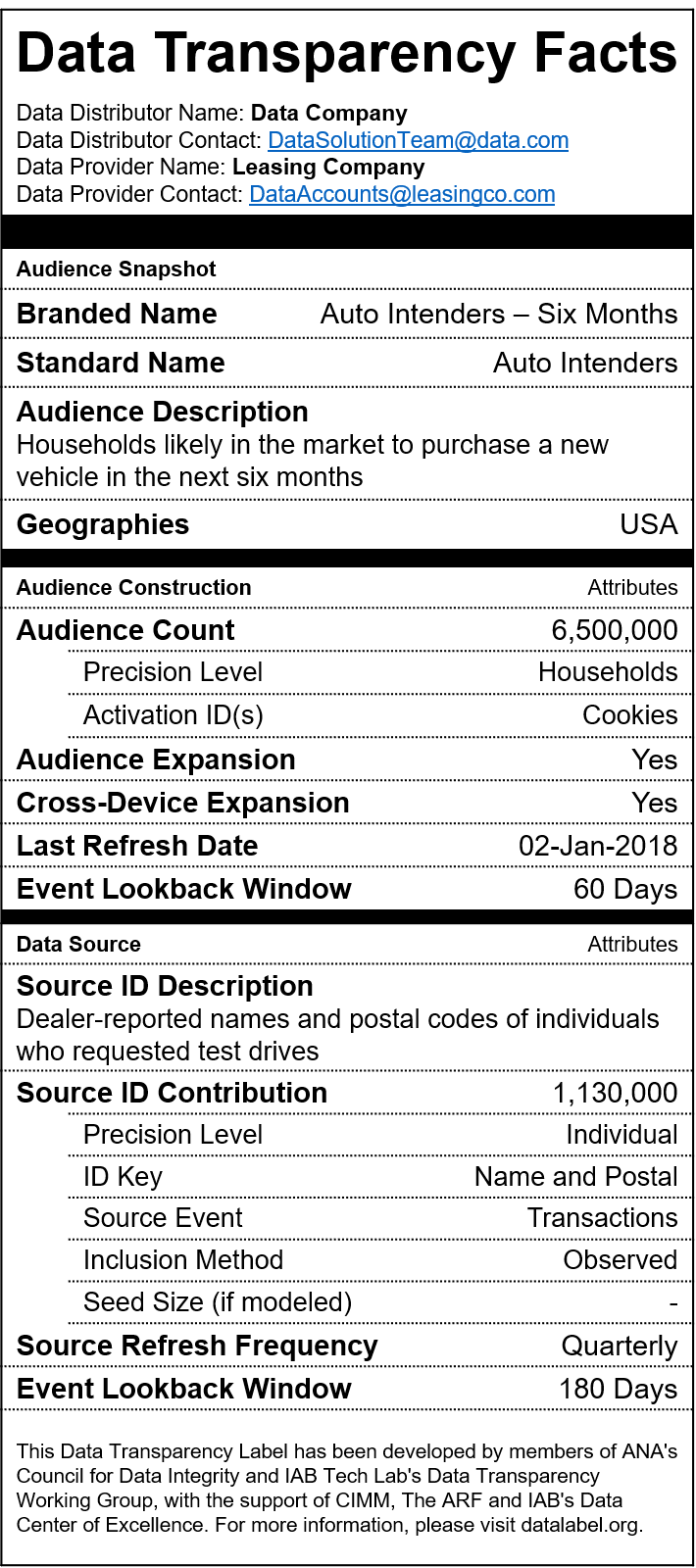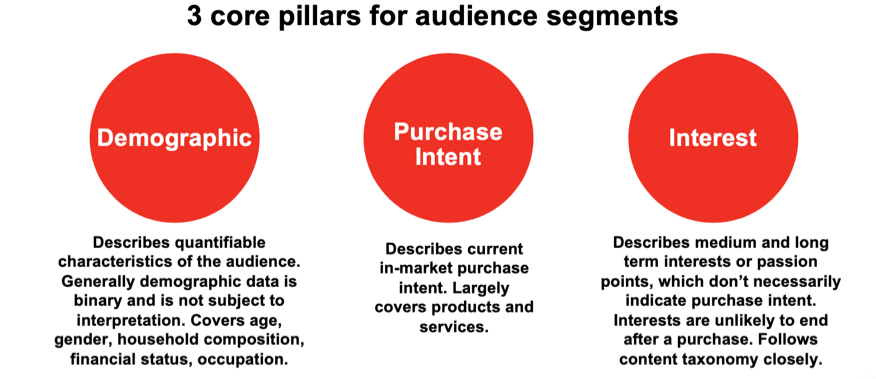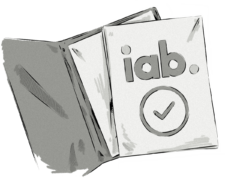Programmatic advertising is made up of many different processes, including media buying, identification, targeting, measurement, and attribution.
The IAB and IAB Tech Lab play a key role in creating, defining, and maintaining industry standards to make these programmatic advertising processes run as seamlessly as possible.
Below we’ve listed the main standards and initiatives from the IAB Tech Lab.
What Is the Interactive Advertising Bureau (IAB)?
The Interactive Advertising Bureau (IAB) is a non-profit trade organization that is responsible for developing technical standards, creating best practices, conducting industry research and educating companies about the importance of online advertising.
Established in 1996, the IAB has over 600 members consisting of publishers, tech companies, advertising agencies, and brands. There are also 42 international licensee organizations in the IAB Global Group.
What Is the IAB Tech Lab?
The IAB Tech Lab is the technical arm of the IAB. It collaborates with IAB Tech Lab members, who include publishers, tech companies, advertising agencies, and brands, to design, develop, and maintain technical standards for use in the programmatic and digital advertising industries.
The Main IAB Tech Lab Standards and Initiatives That You Should Know About
There are 26 standards, initiatives and products that the IAB Tech Lab is currently working on, each of them falling under one of the following focus areas:
- Brand safety and ad fraud
- Identity, data, and consumer privacy
- Ad experiences and measurement
- Programmatic effectiveness
Below, we’ve listed the main ones that you should know about, if you don’t already.
Project Rearc
Project Rearc is an initiative to redesign (or rather, re-architect) the main programmatic advertising and digital marketing processes with a focus on user privacy, while still providing a means for personalization and measurement.
The initiative came about because of the ongoing changes to third-party cookies in web browsers and the proposed changes to IDs in in-app mobile environments.
IDs stored in third-party cookies and mobile IDs (e.g. Apple’s IDFA) have long been used for identifying individuals across different websites and mobile apps.
By being able to identify individuals across different websites and apps, advertisers can show specific ads to specific people, measure the performance of their campaigns, and attribute impressions and clicks to conversions. For publishers, being able to identify individuals on their website allows them to increase their ad revenue as it allows them to inform advertisers whether a website visitor is a member of their audience.
The growing privacy challenges are negatively impacting these very processes. Project Rearc is designed to develop a new set of standards and processes that will still provide ad targeting, measurement, and attribution, but with a stronger focus on privacy than what we’ve seen up until now.
OpenMedia
OpenMedia (including OpenRTB)
The OpenRTB protocol (formerly known as the OpenRTB Consortium) provides AdTech vendors with an API specification that media-buying platforms like DSPs, SSPs, and ad exchanges can use to communicate with each other during real-time bidding (RTB) auctions.
It first began in 2010 and has undergone many changes since. The most recent version is OpenRTB 3.0.
OpenDirect
OpenDirect is a specification that supports automated guaranteed; a media-buying process whereby advertisers purchase inventory directly from publishers via an AdTech platform. The specification provides various benefits to publishers and agencies that improve efficiency and provide greater control over campaign management.
The first version of OpenDirect 1.0 was released in January 2015. The most current version is OpenDirect 2.0.
Authorized Digital Sellers
Ads.txt
Authorized Digital Sellers (ads.txt) is a specification that allows publishers to list their authorized sellers to protect them from domain spoofing and arbitrage. The ads.txt file includes information about a publisher’s advertising technology partners (SSPs, ad exchanges, ad networks, etc).
Advertisers can then match the information listed in a publisher’s ads.txt file with the information contained in a bid request to see whether the two sources match. If they do, then advertisers know that the AdTech platform is authorized to sell the publisher’s inventory.
App-ads.txt
Application Authorized Digital Sellers (App-ads.txt) is an extension of the ads.txt standard which aims to prevent domain spoofing and illegitimate inventory arbitrage in the in-app and over-the-top (OTT) environments. App-ads.txt works in a very similar way to ads.txt, but with a few differences in how the file is hosted.
Ads.txt Aggregator
Ads.txt aggregator is a tool that provides advertisers and agencies with an aggregated list of ads.txt files from over 2 million domains (i.e. publishers).
Ads.cert
Ads.cert is responsible for validating information that passes between buyers and sellers in bid requests.
It does this by cryptographically signing bid requests, which authenticates a publisher’s inventory and allows buyers to track the inventory’s path to make sure they’re only purchasing from authorized sellers.
sellers.json
Sellers.json allows media buyers to see all the sellers and resellers involved in a bid request. The sellers.json is an extension of the ads.txt file, which not only sees the list of authorized sellers and resellers in ads.txt file but also lists the final seller of a bid request.
The OpenRTB Supply Chain Object is part of sellers.json and provides a record of all the sellers (direct) and resellers (intermediaries) that have been involved in bid requests.
By viewing all of the entities (referred to as nodes) involved in bid requests, media buyers can get more transparency into the supply chain, identify whether the entities are partners they want to work with, and see how many entities the bid passed through before it was delivered to publishers.
buyers.json
Buyers.json makes it possible for sellers to identify who is buying their inventory. The buyer.json specification mirrors the seller.json specification but is designed to be used by sellers. Also, it complements the ads.txt, Sellers.json, OpenRTB DemandChain, and the SupplyChain Object standards.
Ad fraudsters use the vulnerabilities and complexities of the digital advertising ecosystem to carry out malvertising attacks across multiple publishers. They move their campaigns from one DSP to another as soon as their actions are spotted, making it difficult for publishers and SSPs to identify the bad actors and block them when they start using a new DSP. The buyers.json spec can also be used to identify and block problematic buyers, e.g. ones that ignore brand safety criteria.
Buyers.json is a mechanism by which the identity of buyers is publicly declared. This helps to cleanse the programmatic advertising system of fraudsters and protect publishers and other users from malicious attacks.
Data Label
The Data Transparency Label is a labelling system used by AdTech vendors to easily state the quality of the data they sell. The labels declare information to advertisers about the origins of the data, how it was collected, whether it was manipulated, plus other pieces of information. Each field aims to give marketers, agencies and publishers a clear summary of the data segments and provide a common taxonomy for the advertising industry.

Transparency & Consent Framework (IAB Europe)
The IAB Transparency and Consent Framework (TCF) aims to support publishers, technology vendors and advertisers in complying with the transparency and user-consent requirements of the GDPR.
The framework was developed in collaboration with a number of publishers, advertisers and other industry players and is governed by the IAB Tech Lab.
It was designed to standardize the process of gaining consent needed to collect and use personal data, such as advertising identifies, device identifiers and other tracking technologies.
CCPA & Other Privacy Frameworks
The California Consumer Privacy Act (CCPA) is intended to provide California consumers with transparency on how companies collect and use their personal information. The CCPA was established in response to changing consumer perceptions towards their online privacy.
CONSENT Act (Customer Online Notification for Shoping Edge-provider Network Transgressions) is a sibling regulation to the CCPA which applies nationwide in the US. The CONSENT Act requires companies to collect explicit consent in order to use, share and sell user data. The CCPA and CONSENT Act are both designed to protect online privacy in the US.
The IAB Tech Lab is currently working on a framework that can help publishers and AdTech companies comply with the CCPA.
SupplyChain Object
The SupplyChain object provides buyers with the ability to identify all the parties involved in the selling and reselling of inventory. During a media-buying transaction, each party involved is represented by a node in the SupplyChain Object.
Buyers are able to cross reference each node in the SupplyChain object against data that comes from sellers.json and ads.txt files and gain detailed information about the sellers.
Video Ad Serving Standards
VAST
Video ad-serving template (VAST) is an XML schema developed by the Interactive Advertising Bureau (IAB) that enables in-stream video ads to be served from video ad servers and played in video players across a number of websites (publishers) and on numerous devices (e.g. desktop, mobile, tablet, etc.).
VAST was created to address the compatibility issues between video ad servers and video players located on websites and adopted as an industry standard.
Prior to VAST, if an advertiser wanted to display a video ad on a publisher’s website, they would have to make sure their video ad-serving protocol was compatible with the publisher’s video ad player, and if it wasn’t, the advertiser (or rather, the video ad-serving platform) would have to create a different response so that it was compatible with that particular video player.
VPAID
Video Player Ad Interface Definition (VPAID) enables video ad units and video players to interact with one another. VPAID allows advertisers to serve rich, interactive ads to users and collect data about how users interact with their video ads. Even though VPAID can be used independently, it is often embedded into VAST.
VPAID has been depreciated and replaced by SIMID and OM.
SIMID
Secure Interactive Media Interface Definition (SIMID) aims to support interactive capabilities and increase transparency and security in video and audio ads displayed on mobile and OTT devices.
SIMID replaces the interactivity functionality that was once carried out by VPAID.
When used with OMID (Open Measurement Interface Definition) and VAST (Video Ad Serving Template), SIMID provides more freedom in terms of interactivity and better integration with ad verification vendors.
Open Measurement (OM)
The IAB Tech Lab’s Open Measurement (OM) spec facilitates open-source, third-party viewability and verification measurement for ads served in mobile app environments.
Moving forward, OM will replace the measurement and verification capabilities carried out by VPAID.
The IAB Open Measurement SDK (OM SDK) provides code and libraries so companies can access viewability and verification information without needing to rely on additional SDKs from other companies.
MRAID
Mobile Rich Media Ad Interface Definition (MRAID) is the standard application programming interface (API) for displaying rich media ads in mobile devices.
MRAID consists of a set of commands which are designed to work with HTML5 and JavaScript to perform a range of functions, such as expanding the ad, resizing it, and gaining access to some device functionalities.
As mobile devices run on various systems and are built using different languages, MRAID eliminates the need to develop different rich media ads for different devices. MRAID gives advertisers the ability to display their rich media ads across all mobile devices in all kinds of applications.
New Ad Portfolio
In July 2017, the Interactive Advertising Bureau (IAB) released a completed version of a new standard known as the IAB Standard Ad Unit Portfolio.
This was the biggest update to ad formats since 2002 and supersedes the universal ad package (UAP).
The Ad Unit Portfolio has been enhanced with new ad units that allow each creative to adjust to a variety of screen sizes and resolutions. The ad units now include ad sizes based on aspect ratio rather than on specific sizes in pixels, and incorporate the LEAN Principles.
SafeFrames
The IAB SafeFrames is an advertising standard that combines the advantages of iframe and Javascript tags and eliminates many of their disadvantages.
The SafeFrame ad slots are implemented in JavaScript with an API that loads the actual ads in iframes, but allows them to interact with its API to expand the content or track viewability. At the same time, it protects the publisher’s site from unwanted changes and prevents visitors’ sensitive information from being collected.
The latest major update to the SafeFrame 2.0 was implemented in 2014 and incorporated key improvements that apply to advances in browser technology, standards, processes such as header bidding, support for current ad formats, and page security, while at the same time respecting user privacy preferences.
There are reports that SafeFrames and MRAID will be merged together to create one API that performs the functions of both standards.
CTV/OTT Guidelines
The growth of CTV and OTT advertising is creating new opportunities for advertisers and publishers. However, it’s also introducing new challenges that are not present in the web and in-app mobile worlds.
The IAB Tech Lab’s OTT Technical Working Group and Digital Video Working Group have been working on addressing these changes and have produced Guidelines for Identifier for Advertising On OTT Platforms, as well as updated VAST to include support for programmatic advertising processes in CTV and OTT.
The OTT Technical Working Group has also provided guidance on using app store identifiers and user agent strings.
App Store Identifiers
In the mobile world, both of the main app stores have their own IDs; Google’s Android uses bundle IDs and Apple’s iOS uses app IDs to inform advertisers whether an app is from an Android device or an iOS device.
In the OTT world, there are several app stores, so the OTT Technical Working Group recommends that each app store use a unique ID to provide consistency and avoid confusion.
Learn more about the app store ID guidelines here.
User Agent Strings
Information from user agent strings is often used to identify the device type, make, model, operating system, and information about the app. This information can then be used for ad targeting, measurement, and attribution.
However, in the CTV world, some of this information is either missing or not properly defined. In order to tackle this problem, the OTT Technical Working Group has proposed a common structure that device makers can use to include and state the correct information.
Audience Taxonomy (data segment categories)
The IAB Audience Taxonomy provides the industry with a common classification of terms for audience segment names to improve management and comparison of data across different providers.

Blockchain Education
Blockchain is a decentralized ledger that comprises various data records to which participants provide either storage or processing resources to further develop and maintain the blockchain.
A peer-to-peer network gathers each individual copy of the ledger through a synchronization process and facilitates the updates once a new validated record is added as a new block of data.
The IAB Tech Lab has set up a working group to research and test possible applications of blockchain technologies, distributed ledgers and cryptography for programmatic advertising.
CATS
The IAB Tech Lab’s Common Ad Transport Standard (CATS) is responsible for regulating communication between any two parties in the advertising technology ecosystem during non-RTB transactions.
CATS is based on industry standards to support interoperability and bridge the gap between one system that requests an ad, or ad component, from another.
In many ways, CATS is akin to OpenRTB 3.0, with the only exception being a lack of a bidding component.
Podcast Measurement Technical Guidelines
The IAB Podcast Measurement Technical Guidelines provide a common measurement language for both podcast content and podcast ads, and includes technical details on request filtering. The guidelines were established by the Podcast Technical Group to reduce the discrepancies that occur between podcast publishers and tech vendors.
Spiders and Bots
The IAB Spiders and Bots list allows companies to remove automated traffic, such as search engine crawlers, monitoring tools, and other nonhuman traffic, from their analytics and advertising reports.
The list also helps companies decrease the number of discrepancies between parties and meet the requirement for General Invalid Traffic from the Media Rating Council’s Invalid Traffic Detection and Filtration Guidelines.







